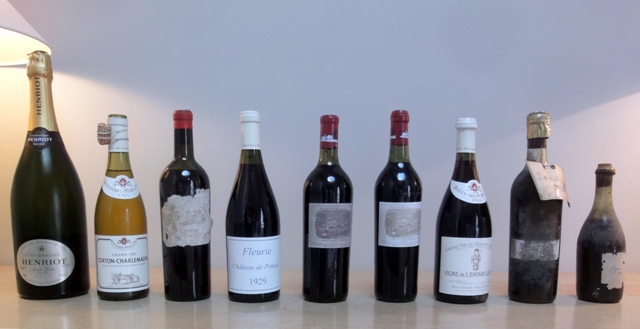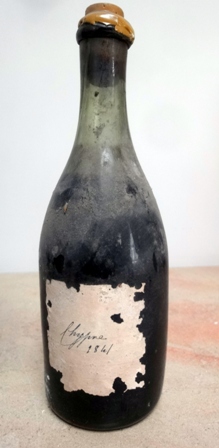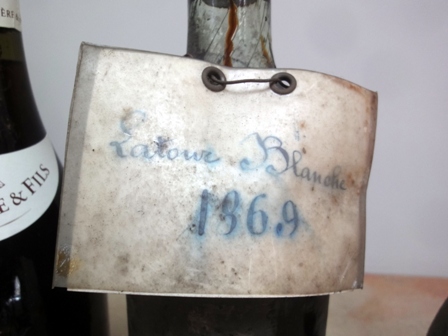As many doubts about old wines were expressed in a recent discussion, I was sad because I was wondering : did they make the good experiments, did they approach the wines as they should be approached?
To cure my sadness I have translated a text of 2010 about one of the most unbelievable dinners that I have lived. It is extremely refreshing for me when I can experience the eternity of wine.
This dinner has been developed with and by the leaders of maison Bouchard Père & Fils. The day included various recent wine tastings at the Domaine de la Romanée Conti and at the Liger-Belair estate, a lunch with Louis Michel Liger-Belair and will feature another tasting of Bouchard wines after the opening of the dinner wines.
At 5 pm precisely, I am ready to open the bottles which are all present in the back kitchen of the castle of Beaune.
A Swiss friend wants to photograph the bottles before they are opened. He came with a small polystyrene tabernacle to make accurate photographs by managing the lighting. I admire this refinement, but my pictures have a definition of points divided by fifty between the picture I take and the one I put on my blog because they have to be reduced. Does the extra precision have so much interest?
My Swiss friend opens the two bottles that he brought with his Swiss friend, and he plays on velvet because the Lafite 1844 and Lafite 1858 were recorked at the castle in 1983. Their perfumes, very close, are promising. My job is harder, because I have to deal with much older corks. The original Margaux 1929 cork is of a magnificent quality. It is flexible, but it did not stick to the glass, which explains a drop in level to the shoulder that I considered acceptable. The friend who brought it has a reserve bottle. In spite of a slightly roasted nose, it seemed useless to open the wine of rescue.
The part is complicated to open the cork of the La Tour Blanche 1869 that I brought. Due to the heat, the wine has a little oozing and surrounded the circumference of the bottle with a fatty liquid. But the level in the bottle is exceptional for a bottle with the original cork: it is at the base of the neck. The cork breaks into many pieces. Stéphane Follin-Arbelet would like to help me, but I prefer to finish without help. All the broken pieces come out and the smell that invades the room is extraordinary. One feels the citrus fruits that will be freed. The wine looks perfect. I am happy. I then open the tiny bottle of Cyprus wine 1841 and the cork is completely glued to the neck of glass. So, when I pull the corkscrew, I only remove a small cylinder from the torn center, and I have to separate the cork from the neck by cutting with a sharp tip of very small pieces. Inevitably crumbs fall into the wine, which I will remove at the time of the service with a spoon directly in the glasses. The perfume of this wine is to be damned. I’ve never smelt anything so heady and peppery.
Stéphane urges us to go to the cellar of the castle to make a vertical tasting of the Chevalier Montrachet La Cabotte Bouchard Père & Fils.
After this tasting, we go back with our glasses of Cabotte 1992 on the beautiful terrace which overlooks the gardens implanted in ancient moats of the city fortress. Joseph Henriot joins us, all smiles, and gratified each one with kind compliments. In our group, from the house of Bouchard, Stéphane managing director and Philippe the man who makes and knows all wines at his fingertips, two Swiss friends, great collectors, one of the main customers of the house Bouchard who sells the wines on a large scale but also organizes great tastings in the four corners of the planet. There is also Allen Meadows, the man who knows best the wines of Burgundy, who has just released a book on the wines of Vosne Romanée. Two journalists will film some moments of our meal, for the archives of the house Bouchard.
On the terrace, we drink a champagne Henriot Cuvée des Enchanteleurs magnum 1959, wine that I appreciate at the highest point. A big fear takes us, because there is in the mouth but not in the nose, a small beginning of cork. Fortunately this small defect disappears and the richness of this champagne butter and lemon, fleshy and charming, delights me. This champagne is first a wine. Joseph Henriot is exciting because he tells us his questions about strategic choices and we are proud to be in the confidence, but he also takes advantage of it to insist on our responsibility to develop the love of quality wines.
The menu composed by Stéphane and directed by Marie Christine is - I think - the most successful of all the dinners I have been invited to in the Orangerie du Château de Beaune. The menu is: Gougères / monkfish medallion with Bresse curry / poultry with morels and wild rice / veal grenadin, cooking juices and vegetables / Cîteaux and Comté / choco- passion. It was very elegant.
The Corton Charlemagne Bouchard Père et Fils 1961 is a sure bet. It has a lemon nose. In the mouth, it’s magic because the candied fruits and the lemon mix. The end of this wine is extreme, with lemon confit. Curry goes well with wine. This Corton Charlemagne overflows with pepper. What is astonishing is the marriage of delicacy and great power.
The Château Margaux 1929 presents itself with a rather tired nose. But we feel that it will improve. Next to him, the Fleurie Château de Poncié 1929 has a very fresh nose. I was astonished that this domain had kept the 1929, but the explanation exists: this estate belonged to the Bouchard house which had a strategy of preserving a “library” of vintages of its wines. It is therefore normal that they kept the 1929. The castle of Poncié left the Bouchard group and Joseph Henriot bought it recently to integrate it again to his group.
On the palate the Margaux is very pretty and velvety. It has a very feminine charm. And his small weaknesses miraculously disappear with morels. The Poncié has menthol aspects. It is very pretty, old wood, with great charm due to its length. There is wood and coffee. This remarkably preserved wine is an example of the interest of Beaujolais de garde. The bitterness is compensated by the beautiful density.
When we are served side by side the Château Lafite Rothschild 1844 and the Château Lafite Rothschild 1858, we become aware that we are entering a world that is the grail of any wine lover. I observed the bottles my friend opened. The original bottles are very old. Recent labels show nothing special, except the vintage and there is a counter label which indicates that the wines were reconditioned at the castle in 1983. Everything appeared to me authentic.
The color of the wines is unreal, because there is not a gram of tile. There is ruby on the edges. The nose is elegant. The wines are very acid, but really elegant. Their youth is confounding. I find the 1844 much more brilliant, with a richness that evokes me Lafite 1961. It has a crazy structure, an incredible density. I find that crazy. We swim in the unreal, with incredible structures and rare aromatic power. The nose of 1858 is delicate. Some prefer the 1858 and I tell them that it is because he is the most bourguignon of the two. The 1844 has the breed and power of a great 1961 and the 1858 flourishes better and is progressively more elegant. But the 1844 conquered me. While I taste, my senses are alert to try to track a possible addition to these wines. But in my opinion it would be impossible to have these balances with wines that would not be completely homogeneous.
Joseph Henriot is an agronomist, so he wonders what would explain a specificity of prephylloxeric wines that would give them this longevity. I am not an expert on this issue, but my Swiss friends and I drank a lot of prephylloxeric wines and it is undeniable that there is a spectacular aging potential in them. Is it because they have been present for a millennium, these varieties felt well in those geological layers that suited them? This idea would please me.
The time has come for the Beaune Greves Vigne de l’Enfant Jésus 1865. Joseph Henriot and Stéphane recall the story of the young Carmelite who had predicted that Anne of Austria would have a child and whose congregation was rewarded from this piece of land called Enfant Jésus. The nose of the wine is extremely bourguignon, with a confusing charm. What strikes me is the perfect balance of this wine with so unreal youth. I think this sublime wine is not the best of the three that I have drunk from this year for this wine. But we are at the top of what Burgundy has given in this historically grandiose year.
All my friends are almost K.O. seated so much the Chateau la Tour Blanche 1869 is of infinite perfection. The perfume is of rare power. On the palate, the wine is of an unheard-of charm. Despite its black color, there is almost no caramel and citrus fruits dominate. We often speak of sauternes who eat their sugar and I remember a Filhot 1858 drunk in this same place that had lost its sugar. This wine of 1869 has kept all its sugar and it is so powerful that it looks like a great Yquem and it evokes me a little the 1861 that I adored and for my Swiss friend it is the Yquem 1869 that he has already drunk three times. He thinks the two are alike. In my opinion this wine is “the” sauternes perfect, with an incomparable enjoyment in mouth. The fat of this wine on a sweet and citrus background is unique.
It is time to share with my friends the Cyprus Wine 1841. It is the only bottle of this year that I have and I took it by game, to offer a wine older than the 1844! The perfume of this wine is incredibly powerful. The feeling of alcohol is very strong. And what makes the charm, unique for me who is crazy about it, is that the strong alcohol is refreshed by a dominant pepper. And wine is a delicacy, mixing power, alcoholic strength with a finesse created by pepper. There is no other wine that has this infinite length.
We are all aware that we have just experienced something unique. Because the quality of all the wines was at the rendezvous. We have seen that wines can approach eternity. Not being the organizer of this dinner, I did not ask that we vote.
My vote would be: 1 - Château La Tour Blanche 1869, 2 - Château Lafite Rothschild 1844, 3 - Beaune Grèves Vigne de l’Enfant Jésus 1865, 4 - wine of Cyprus 1841, 5 - Château Lafite Rothschild 1858.
If I did not put first the Beaune Greves 1865 which was perfect, it is mainly because there was no novelty that this sauternes 1869 absolute perfection offered me. And the 1844 is so much above what I expected from these Lafite that it had to be crowned in good place.
The Bouchard House has created this unique opportunity to drink some of their cherished treasures and bring together lovers of ancient wines around bottles of legend. In my life as a collector - and drinker - of ancient wines, this is perhaps the biggest dinner I have ever been to (this was written in 2010 - other events have appeared since).
Thanks to Henriot and my friends for this unforgettable event.


